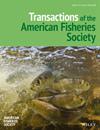钢头补充计划的人口统计学和遗传后果
IF 1.4
3区 农林科学
Q2 FISHERIES
引用次数: 0
摘要
通过增加孵化场产卵的个体来补充自然产卵的种群,通常用于恢复受威胁和濒危种群,并支持收获机会。我们对虹鳟(Oncorhynchus mykiss)的溯河形式steelhead进行了分析,该分析在15年的时间里返回到华盛顿西南部的一个综合补充种群中。补充计划的目标是评估是否可以使用幼年圈养亲鱼和综合模式来提高成鱼的回报,同时避免对种群产生负面的遗传影响。在孵化场产卵的鱼的相对繁殖成功率(RRS)的估计值从孵化场雌性的2.4到自然来源雄性的6.4不等,这表明在孵化场产卵的鱼比在自然环境中产卵的鱼产生更多的成年后代。我们观察到,在自然环境中产卵时,孵化场来源的鱼(相对于自然来源的鱼)的繁殖成功率(RS)略有降低,但对雄性来说差异不显著,对雌性来说差异略微显著。相比之下,RS与产地的关系相对较弱(男性P = 0.347, η 2 = 0.008;雌性P = 0.066, η 2 = 0.037),我们观察到RS与回归年份有很强的关系(雄性P <0.001, η 2 = 0.896;女P <0.001, η 2 = 0.867)(即孵化场和天然来源的鱼每年在一起表现良好或较差)。孵化场源鱼表现出遗传多样性的降低,同时有证据表明孵化场源鱼之间的时间种群结构增加。我们怀疑后者是文化习俗的产物,它减少了色情年龄的多样性。我们得出的结论是,该计划成功地实现了成年回报的增加,但未能避免对种群的负面遗传影响,并且补充的任何持久影响仍有待确定。本文章由计算机程序翻译,如有差异,请以英文原文为准。
Demographic and genetic consequences of a Steelhead supplementation program
Abstract Supplementation of naturally‐spawning populations by the addition of hatchery‐spawned individuals is commonly conducted for recovery of threatened and endangered populations and to support harvest opportunities. We present an analysis of steelhead, the anadromous form of Rainbow Trout ( Oncorhynchus mykiss ), returning to an integrated supplemented population in Southwest Washington over the course of 15 years. The goal of the supplementation program was to evaluate whether use of a juvenile captive broodstock and an integrated paradigm could be used to increase adult returns, while avoiding negative genetic impacts to the population. Estimates of relative reproductive success (RRS) for fish spawned in the hatchery ranged from 2.4 for hatchery‐origin females to 6.4 for natural‐origin males, indicating that fish spawned in the hatchery produced more returning adult progeny than did fish allowed to spawn in the natural environment. We observed a slight reduction in reproductive success (RS) for hatchery‐origin (relative to natural‐origin) fish when spawning in the natural environment, but the difference was non‐significant for males and marginally significant for females. In contrast to the relatively weak relationship between RS and origin (male P = 0.347, η 2 = 0.008; female P = 0.066, η 2 = 0.037), we observed a strong relationship between RS and return year (male P < 0.001, η 2 = 0.896; female P < 0.001, η 2 = 0.867) (i.e., hatchery‐ and natural‐origin fish did well or poorly together each year). Hatchery origin fish exhibited reduced genetic diversity, as well as evidence of increased temporal population structure among hatchery fish. We suspect the latter is an artifact of culture practices that reduce diversity in age at smoltification. We conclude that the program was successful in achieving an increase in adult return, but not in avoiding negative genetic effects on the population, and that any lasting impacts of supplementation remain to be determined.
求助全文
通过发布文献求助,成功后即可免费获取论文全文。
去求助
来源期刊
CiteScore
2.90
自引率
7.10%
发文量
48
审稿时长
8-16 weeks
期刊介绍:
Transactions of the American Fisheries Society is a highly regarded international journal of fisheries science that has been published continuously since 1872. It features results of basic and applied research in genetics, physiology, biology, ecology, population dynamics, economics, health, culture, and other topics germane to marine and freshwater finfish and shellfish and their respective fisheries and environments.

 求助内容:
求助内容: 应助结果提醒方式:
应助结果提醒方式:


